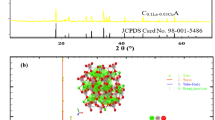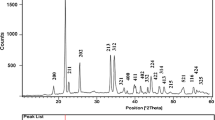Abstract
Thermoluminescence (TL) response of newly synthetic silicon-activated Ca9AlP7O28 nanophosphor doped with different concentrations (0.3–10 mol%) (abbreviated as CAP: Six) were prepared by the sol–gel method. The optimum concentration of Si ions for the best TL response was found to be 0.3 mol% (CAP: Si0.3), which was selected for subsequent dosimetric measurements. Phase purity and the crystal structure of the CAP: Si0.3 sample were identified and verified using X-ray diffraction (XRD) and transmission electron microscopy (TEM) analysis, where results obtained confirmed the successful synthetic method used in the preparation of the nanophosphor samples. Scanning electron microscope (SEM) and energy dispersive X-ray (EDX) mapping revealed the localization of constituent elements and indicated the homogeneous distribution of Si-ions as well as the feasibility of dopants in the herein sample. The dosimetric properties of the CAP: Si0.3 sample, including glow curve structure, reproducibility, repeatability, dose–response and fading effect, were extensively investigated. The gamma irradiated CAP: Si0.3 sample exhibited a simple glow curve of a single prominent peak centred at 222 ± 1.33°C with considerably high TL intensity (1.22 relative to MTS-700 TLD detector). The relative standard deviation (RSD) of peak areas of CAP: Si0.3 were 5.25 and 2.7% for reproducibility and repeatability studies, respectively. These values of RSD were <10%, so they were acceptable internationally. A good linear dose–response relationship was achieved over a dose range of up to 20 Gy with an excellent correlation coefficient of R2 = 0.9969 and a calibration factor of F = 51.75 × 107 a.u./Gy. Almost no fading was registered from the studied CAP: Si0.3 sample after irradiation. Zeff values were found to be in the range 11.62 to 11.61, which are closely related to that of natural bone (11.3 to 11.8). Minimum detectable dose of CAP: Si0.3 had a value of 11 μGy. The outstanding features of this herein-prepared sample make it a good TLD nanophosphor, very suitable for personnel and environmental dosimetry of γ-radiation within the studied dose range.













Similar content being viewed by others
References
Sueo M 1995 Radiat. Phys. Chem. 46 399
Andrzej G C and Mohammad H S 2004 Radiat. Phys. Chem. 71 17
Sueo M 1996 Radiat. Phys. Chem. 47 333
Jimmy C H, Puhl J M, Stephen M S, William L M, Marc F D, Debra L B et al 1998 NIST Special Publication 250–44 40
Hossam A O, Hany A, Abdel Azim H, Hussein E, Sufyan A A and Intesar A E 2021 Ceram. Int. 47 27789
Intesar A E, Sufyan A A and Hossam A O 2020 J. Lumin. 227 117555
Intesar A E and Sufyan A 2018 J. Non-Cryst. Solids 482 236
Intesar A E, Noha K E, Abdel Azim E H, Hussein M E and Sufyan A A 2016 J. Lumin. 31 1433
Intesar A E, Abdel Azim E H, Hussein M E and Sufyan A A 2014 Isot. Radiat. Res. 46 277
Abdullah M N, Yusoff M A, Rosli H M and David A B 2001 Radiat. Phys. Chem. 61 497
Unniyattil M, Jose M T, Akihiro T, Hoffmann W and Arunachalam R L 1999 J. Lumin. 82 221
Arunachalam R L, Jose M T, Vinoth K P and Pardeep V K 2002 J. Phys. D: Appl. Phys. 35 386
Sambhaji S S, Bhushan S D, Tumkur K G R and Buhwan C B 2001 J. Phys. D: Appl. Phys. 34 2683
Sahare P D and Sanjiv V M 1990 J. Phys. D: Appl. Phys. 23 567
Sanjay J D, Sanjiv V M, Suresh M D, Pradeep L M and Vivek K K 1993 Phys. Status Solidi (a) 135 289
Fariha H, Georgios K and Salome C 1985 Nucl. Instrum. Methods Phys. Res. Sect. B 9 218
Noman S, Sahare P D, Satya P L and Partik K 2006 Radiat. Meas. 41 40
Noman S, Sahare P D and Alexander A R 2007 J. Lumin. 124 357
Satya P L, Sahare P D, Ramswaroop S C, Noman S, Rajiv R and Akhilesh P 2007 J. Phys. D: Appl. Phys. 40 1343
Nandkumar T M, Sahare P D, Makarand K, Bhuwan B, Vasanth N B and Sanjay D D 2014 J. Lumin. 146 128
Nandkumar T M, Sahare P D, Bhushankumar P, Bhoraskar Vasanth N and Sanjay D D 2013 Nucl. Instrum. Methods Phys. Res. B 315 273
Sahare P D, Rajiv R, Noman S and Satya P L 2007 J. Phys. D: Appl. Phys. 40 759
Juan M M, Raquel B, Carlos C V, Salcido Romero E G and Castaño V M 2010 Radiat. Prot. Dosim. 139 580
Vsevolod S K, Nikiforov S V, Moiseikin E V, Alexander S V and Simanov A G 2013 Solid State Phys. 55 2088
Vsevolod S K, Anatoliy E E, Zatsepin A F and Nikiforov S V 2008 Radiat. Meas. 43 341
De Azevedo W M, Giovana B D O, Edelido F D S J, Khoury H J, de Ferreira E O and J, 2006 Radiat. Prot. Dosim. 119 201
Matthew W B, Luiz G J, Stephanie C T, Özkan U, Brydon L B, Eduardo G Y et al 2010 J. Lumin. 130 825
Noman S, Zafar H K and Sameh S H 2011 Nucl. Instrum. Methods Phys. Res. B 269 401
Geeta R and Sahare P D 2013 Nucl. Instrum. Methods Phys. Res. B 311 71
Nandkumar T M, Vijaykumor B V, Makarand S K, Bhuwan C B, Sahare P D, Shital A R et al 2020 Nucl. Instrum. Methods Phys. Res. B 466 90
Rohit K R, Amit K U, Rajiv S K and Sanjay J D 2012 J. Lumin. 132 210
Vladimir N M, Aleksandr L, Ch B L, Marco K, Evegni A V et al 2008 Nucl. Instrum. Methods Phys. Res. B 266 2949
Adrie J J B 2001 Nucl. Instrum. Methods Phys. Res. B 184 3
He X, Zhu Z, Lijian H and Fachuang L 2016 Rare Met. Mater. Eng. 45 1659
Doory K, Han E K and Chang H K 2016 PLoS ONE 1 11
Preethi R, Sridhar K, Amar B, Rajkumar R and Eric L C 1988 J. Mater. Res. 3 810
Jeffery C B and George W S 1990 Sol-gel science: the physics and chemistry of sol-gel processing (Academic press an Imprint of Elsevier. Depatment of Oxford, UK)
Mulder C A M, van Leeuwen-Stienstra G, Van Lierop J G and Woerdman J P 1986 J. Non-Cryst. Solids 82 148
Johan H H and Stephen M S 1995 Tables of X-ray mass attenuation coefficients and mass energy-absorption coefficients 1 keV to 20 MeV for elements Z=1 to 92 and 48 additional substances of dosimetric interest (National Inst. of Standards and Technology-PL, Gaithersburg (United States: NIST)
Ahmed E, Abdul Azim H, Hussein E, Noha K, Amin E and Hossam D 2011 J. Radioanal. Nucl. Chem. 288 65
Daphne F J and Hawkes D J 1981 Phys. Rep. 70 169
Parthasaradhi K 1968 Studies on the effective atomic numbers in alloys for gamma-ray interactions in the energy region 100 to 662 keV (Andhra University, Waltair, India)
Leif G, Guilbert N, Bjørn Jensen K and Levring H 2004 Radiat. Phys. Chem. 71 653
Chen R, McKeever S W S 1997 Theory of Thermoluminescence and related phenomena (Singapore: World Scientific)
Nil K, Aziz H G, Mehmet Y, Tamer D and Mustafa T 2015 Appl. Radiat. Isot. 104 186
Ilich B M 1979 Sov. Phys. Solid State 21 1880
Mahmoud S R, Mahmoud A E and Mohamed A H 2006 Radiat. Eff. Defects Solids 161 579
May C E and Partridge J A 1964 J. Chem. Phys. 40 1401
Carlo M, Ricci A and Sergi A 1968 Ric. Sci. 9 762
Barbara O, Paweł B, Krzysztof H and Peter M 2014 High-level TL Dosimetry for high-temperature environment, RAD Conference, Nis, Serbia
Leticia L C and Mateus F L 1986 Radiat. Prot. Dosim. 14 333
Author information
Authors and Affiliations
Corresponding author
Rights and permissions
Springer Nature or its licensor (e.g. a society or other partner) holds exclusive rights to this article under a publishing agreement with the author(s) or other rightsholder(s); author self-archiving of the accepted manuscript version of this article is solely governed by the terms of such publishing agreement and applicable law.
About this article
Cite this article
El-Mesady, I.A., Alawsh, S.A., Hussein, A. et al. A Si-activated Ca9AlP7O28 nanostructure: synthesis and thermoluminescence characteristics. Bull Mater Sci 47, 16 (2024). https://doi.org/10.1007/s12034-023-03082-3
Received:
Accepted:
Published:
DOI: https://doi.org/10.1007/s12034-023-03082-3




